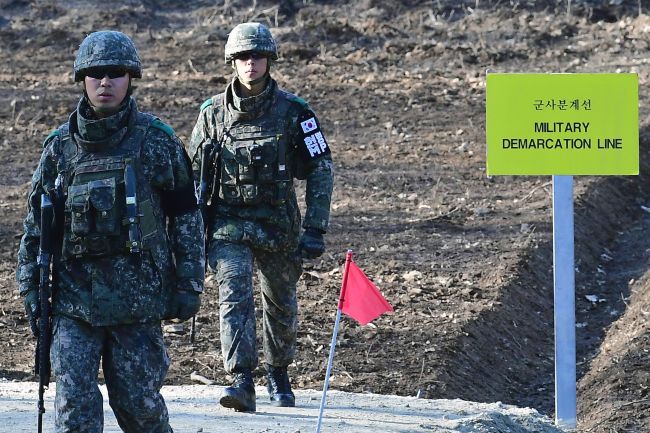In a mountainous region where the two Koreas engaged in one of the fiercest battles during the 1950-53 Korean War, the two sides’ soldiers met in an unusual encounter earlier this month, decades after the war ended without an official peace treaty.
While uniformed soldiers carried rifles on their way to Arrowhead Ridge inside the Demilitarized Zone, taking control of the stronghold was not their mission.
 |
South Korean soldiers walk at Arrowhead Ridge as they build a tactical road across the Military Demarcation Line inside the Demilitarized Zone (DMZ) in Cheorwon, Gangwon Province, South Korea Thursday on Nov. 22. (Yonhap) |
Their goal was to open a narrow road linking the two Koreas that would facilitate the excavation of the remains of those killed during the war. Some 300 war remains are thought to be buried at Arrowhead Ridge, including those from South Korea, the US and France.
“If there are any items that require consultation, please tell us whenever possible,” one of the South Korean soliders told their North Korean counterpart, according to the Ministry of National Defense. The ministry declined to reveal the identity of the solider and the exact date of the conversation.
The connection of such roads is one of the significant transformations inside the DMZ since the two Koreas signed a comprehensive military agreement in September. During the inter-Korean summit in Pyongyang, the two Koreas’ defense chiefs agreed on a series of measures aimed at building trust and easing tension.
Last week, North Korea demolished 10 guard posts as a preliminary step to honoring the inter-Korean military agreement. The two Koreas pledged to destroy almost every guard post after removing firearms and soldiers from the posts. Only a few of the structures will remain standing for their historic value.
Disarming of the DMZ is most vividly seen at the area where the two Koreas’ guards had been standing face-to-face with their guns at ready. Carrying weapons is now strictly forbidden inside the Joint Security Area.
“It is a transformative measure that we could not have imagined before,” Kim Do-gyun, head of the North Korea Policy Bureau at the Ministry of National Defense who has led general-level talks with North Korea, said during a meeting with his North Korean counterpart at JSA last month.
The Defense Ministry said while restrictions remain in place for tourists at the JSA, the military will soon open up the restricted area for full-fledged cross-border tourist program.
Two Korea’s joint efforts to recover war remains will also pick up speed once the inter-Korean roads are established by the end of this year. The joint excavation process will take place April 1 to Oct. 31, 2019.
With South Korea receiving sanctions exemptions from the UN Security Council for a joint survey for reconnecting inter-Korean railways, the government’s hope is up that building the road for excavation will lead to broader cooperation between the two Koreas.
“If people and materials go back and forth on that road, it will become a good infrastructure for building peace,” said Choi Jong-kun, presidential secretary for peace and arms control, one of the key architects of the inter-Korean military agreement.
“Of course, we have to be cautious about every single step we take. (But) that is the step we have to take together. We will continue with our steps prudently by communicating with the people and the neighboring countries,” Choi said in a video interview posted by Cheong Wa Dae.
(
jasonyeo@heraldcorp.com)








